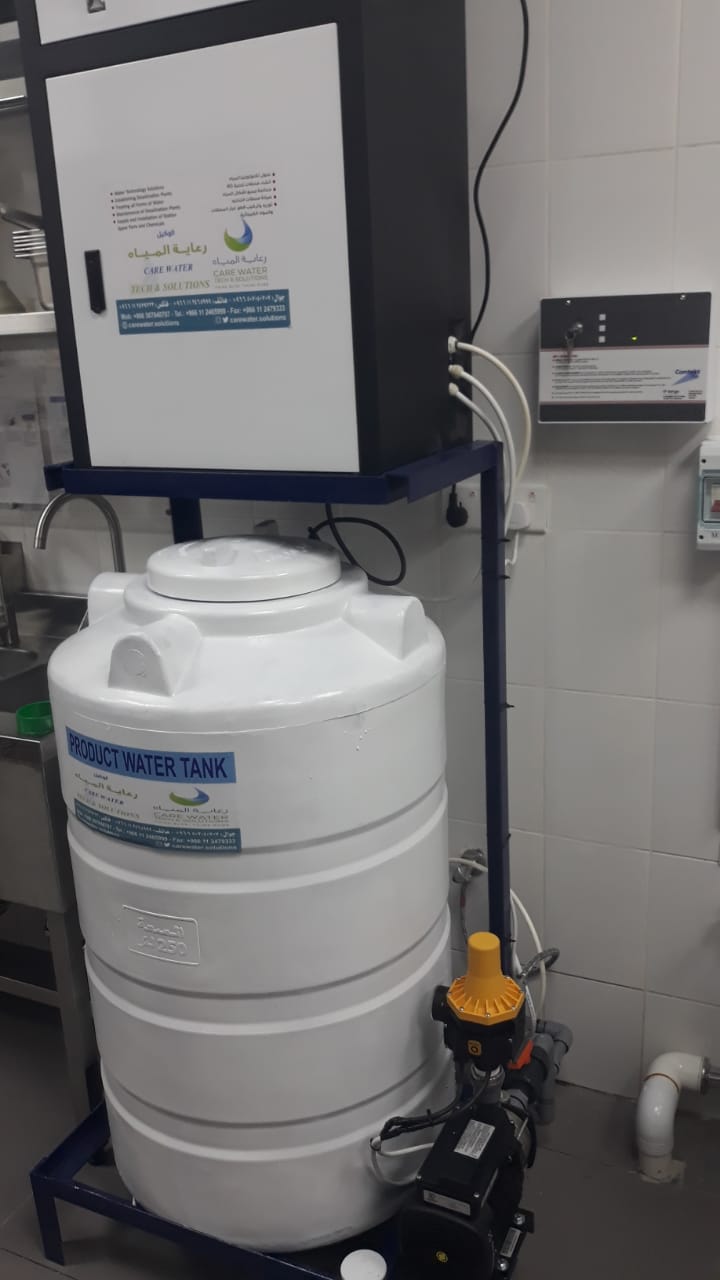
Why is installing a water desalination plant one of the most important steps for preparing restaurants
Desalination plants are the ideal solution to provide potable water. Especially if it is needed in large quantities. Despite the relatively high financial cost, which makes it suitable for places without others, such as (large restaurants – farms – hotels – tourist resorts – palaces, and large villas…..).
However, it has many long-term benefits, whether financially or healthily, and even in the quality of the final product provided.
Read this article here.
Types of desalination plants when preparing restaurants
The first type: is water desalination plants for the main water network
Usually, this type of desalination plant is used to provide large quantities for consumption at one time. Which is what classic water desalination filters (household filters) cannot do. Where the main water arriving at the site is taken from the main water line and brought to the desalination plant to be purified and collected in a water tank for use.
This type of desalination plant is simple and uncomplicated.
The second type: desalination plants for groundwater wells
The installation of these stations for preparing restaurants depends on some special conditions that must be taken into account and provided in advance, the most important of which are:
Accurate analysis of the existing well water to know the number of salts, minerals, impurities, germs, and bacteria.
The amount and strength of the flow of water leaving the well.
The volume of water required for use (the production capacity of the plant per day).
After the necessary work, a study of the required station is drawn up according to the results, and this determines the cost, quality and method of designing and equipping the appropriate station, taking into account the amount of water required to be provided, and based on the results, the size, and type of the station is determined.
Site requirements for the installation of a desalination plant when preparing restaurants:
For the installation of a desalination plant, the site must be equipped with some basic requirements:
- The presence of an isolated and well-ventilated room to install the desalination plant inside and to protect the station and its equipment from dust, dirt, rain, and heat of the sun.
- Securing a water tank before and after the station, according to the required productivity.
- Securing a water pump with an automatic compressor that is installed after the potable water tank to ensure a good water pressure for use.
- Provide the appropriate electric current where the required electricity is determined according to the required station (2 phase – 3 phase) to operate high-pressure pumps, low-pressure pumps, and chemical injection pumps – if any.
Note:
The duration of the implementation and completion of the work varies according to the type of station and the required productivity, in addition to preparing the site and providing its requirements. This is determined when studying and previewing the site.
Why Reverse Osmosis is the Best Water Treatment Technology:
- Minimum energy requirements.
- One of the highest usage rates.
- One of the best filtration rates on the market.
- Remove between 96 and 99% of most contaminants.
What is the definition of reverse osmosis? How does it work?
Osmosis is the passage of water through a protein membrane (such as our skin, or inside a plant cell) to balance the concentration of molecules dissolved in the water.
A protein membrane allows water to pass through, but molecules larger than water (things like minerals, salts, and bacteria) cannot.
The water flows back and forth until the concentration is equal on both sides of the membrane, and an equilibrium is formed.
What types of water sources does reverse osmosis treat?
Reverse osmosis is the ideal water treatment solution for most types of water. All major water sources can be divided from a treatment point of view into three main categories: tap water, also known as municipal sources, groundwater, and saline water. The biggest difference between these three types is the total dissolved solids (TDS) content of each type. As a general rule, the American Health Association requires that drinking water be less than 1,000 ppm dissolved solids.
Tap water usually comes through a pre-existing infrastructure such as a city pipe or dam system. Reverse osmosis is often used in a tap water environment to reduce hardness. Or debris accumulating in water from traveling in metal pipes. Dissolved solids are often a target of water purification in tap water systems. This type of reverse osmosis system is ideal in places such as power plants, pharmaceuticals, laboratories, and hospitals, where the degree of water purity is critical to the industry. Tap water usually has a TDS of fewer than 1,000 parts per million.
Underground reservoirs are often brackish or hypersaline, meaning they contain large amounts of salt, but not enough to be salt water. Groundwater reverse osmosis is very common and is one of the best uses of a reverse osmosis system to date. It is often purified for the agricultural industry, mining industry, and residential uses. Groundwater is a distinct target for the bottling industry, as the unique mineral compositions often have an attractive taste. Saltwater usually has a TDS of 5,000 ppm or less, but can come in concentrations as high as 12,000 ppm.
Saltwater reverse osmosis (sometimes referred to as desalination) is converting salt water into drinking water. Ocean water has up to 45,000 ppm TDS. Usually, for environmental reasons, a borehole is drilled in the ocean for this type of reverse osmosis, but open consumption is more cost-effective. The largest uses of desalination are to provide water in areas that lack a regular supply of fresh water.
























